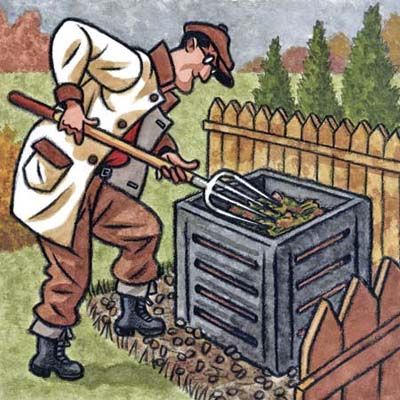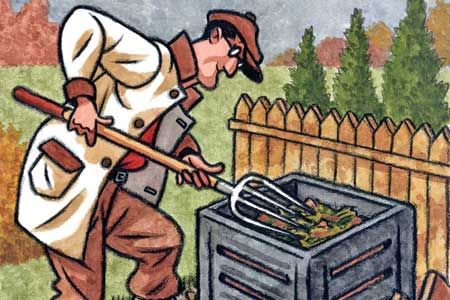Fall is an ideal time to start composting, turning your yard waste and kitchen scraps into nutrient-rich soil for your garden. By beginning your compost pile in fall, you’ll have an abundance of fertilizer ready to nourish your plants come spring. Below, we cover seven important things to know about composting.
Appropriate Compost Location

Select a level area approximately 5 feet square, ideally in a spot that receives partial shade and is protected from direct roof drainage. Begin by clearing the ground of grass to create a clean base for your pile.
You have several options for containing your compost:
- Create a simple pile directly on the cleared ground.
- Use a store-bought composting bin or tumbler.
- Build a do-it-yourself (DIY) enclosure using chicken wire, scrap lumber, or cinder blocks.
If you opt for a DIY enclosure, aim for dimensions of about 3 feet square. Ensure there are gaps in the sides to allow for proper air circulation, which is essential for the composting process. A well-chosen location and appropriate containment will set the stage for successful composting.
Good Compost Materials
Creating a successful compost pile is similar to following a recipe—you need to combine the right ingredients in the correct proportions. The key components of compost are often referred to as “browns” and “greens.” Browns are carbon-rich materials such as leaves, twigs, wood chips, shredded newspaper, and cardboard. Greens are nitrogen-rich materials such as fruit and vegetable scraps, grass clippings, coffee grounds, and eggshells. Vary the types of browns and greens to provide a well-rounded nutrient base for your compost.
Aim to layer browns and greens in roughly equal amounts throughout your pile. To speed up decomposition, chop or shred bulky materials such as branches before adding them to the pile. Store food scraps in a sealed container indoors before transferring them to your compost pile to avoid attracting pests. This balanced approach will result in even and efficient decomposition.
When spring arrives and you start mowing your lawn, you can add grass clippings to your compost pile. However, only use clippings from untreated lawns, as pesticides can harm the beneficial microbes essential for composting.
Compost Materials To Avoid
While many organic materials are suitable for composting, some items should be avoided to maintain a healthy, odor-free pile. Steer clear of adding the following to your compost:
- Chemically treated paper products
- Chemically treated yard waste
- Cooking oils
- Dairy products (cheese, butter, milk)
- Diseased plants
- Meat scraps
- Pet waste
These materials can attract pests, create unpleasant odors, or introduce harmful substances into your compost, which will affect your garden. Additionally, nonbiodegradable items such as plastic, glass, and metal should never be added to a compost pile. These materials do not break down and will contaminate your final product. Always read labels and avoid any waste that might contain harmful chemicals.
Compost Aeration
Proper aeration is essential to a healthy compost pile. Oxygen is a must for the microbes that break down organic matter, and regular turning helps distribute air and moisture throughout the pile. Here are some tips for effective aeration:
- Use a pitchfork or shovel to turn the pile about once per week.
- If using a compost tumbler, rotate it regularly.
- You may want to invest in a compost turner, which has a long handle and paddle-like bottom for easier turning in enclosed bins.
- Add loose, lightweight materials such as bark mulch to create air pockets and prevent compaction.
If your compost pile doesn’t receive enough oxygen, anaerobic bacteria will thrive, producing hydrogen sulfide and resulting in a foul, rotten-egg smell. Regular aeration helps prevent this issue and keeps your compost healthy.
Adequate aeration also helps control moisture levels and temperature within the compost pile. By turning the pile frequently, you ensure all materials are evenly decomposed, leading to a more consistent final product. This step is key to producing high-quality compost.
The Right Amount of Water for Composting
Your pile needs a certain amount of moisture for successful composting, even in winter. Your compost pile should have the consistency of a wrung-out sponge—damp but not waterlogged. Follow these guidelines to ensure optimal moisture content:
- Lightly mist each layer of browns and greens as you add them to the pile.
- Use a garden hose sprayer or watering can for even distribution.
- Test moisture levels by squeezing a handful of compost. If water drips out when squeezed, turn the pile a few times to allow excess moisture to evaporate.
Don’t be alarmed if you notice worms in your compost—they’re actually beneficial and indicate a healthy pile. These decomposers help break down organic matter and improve soil structure. Proper watering ensures that the composting process remains active.
In dry climates, you might need to monitor your compost pile more frequently to prevent it from drying out. Conversely, in wet climates, ensure your pile is adequately covered to prevent it from becoming too wet. Balancing moisture levels fosters microbial activity in your compost.
Maintaining Compost Temperature
Even in cold weather, a well-maintained compost pile will generate heat as microorganisms break down organic matter. The ideal internal temperature for your compost pile is between 105 and 145 degrees Fahrenheit. Here are some tips for monitoring and maintaining the right temperature:
- Adjust the pile’s size. Larger piles tend to retain heat better than smaller ones.
- For a cool pile, try adding a commercial compost starter to introduce more beneficial microbes.
- If the pile is too hot, aerate it more frequently and consider adding more brown materials.
- Look for steam rising from the pile, which is a normal sign of active decomposition.
- Use an elongated soil thermometer to check the pile’s internal temperature.
Temperature fluctuations are normal throughout the composting process. You can insulate your compost pile with straw or a tarp during colder months to help retain heat and maintain microbial activity. In warmer months, shade the pile to prevent it from drying out.
How To Know When Compost Is Ready
One way to test if your compost is ready for use is by conducting a simple grass-growing test. Take a handful of compost and place it in a small pot. Sprinkle a few grass seeds on top. Water lightly and place the pot in a warm, sunny location. Monitor the pot for about a week. If the grass seeds sprout within a week, your compost is ready to use.
If the seeds fail to sprout, the compost might need more time or adjustments to its composition. This simple step can save you time and ensure you’re adding fully decomposed, nutrient-rich compost to your garden.

